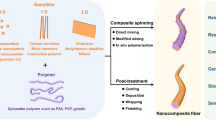Abstract
We report the microscopic, magnetic and rheological properties of magnetorheological elastomers (MRE) with carbonyl iron magnetic particles (CIP) dispersed into silicone in the concentration range 5–30% volume content. The samples have been fabricated under the action of a magnetic field (anisotropic A-MRE) or without it (isotropic I-MRE). For the A-MRE samples and at low particle concentration, the anisotropy is evident in the microstructure and the magnetic properties. However and at high particle concentration, the microstructural and magnetic anisotropy is much less noticeable and makes difficult to distinguish between isotropic and anisotropic state. The rheological characterization shows changes in the storage modulus G′ when CIP content is from 5 to 30% volume and I-MRE (72% change) and A-MRE (70% change) character of the samples. However, this influence is remarkable in the loss modulus G″ with big changes when considering CIP content from 5 to 30% volume and I-MRE (114% change) and A-MRE (142% change). We have also determined that the anisotropic samples with high particle content present the maximum magnetorheological effect of about 31% at low frequency (1–2 Hz).








Similar content being viewed by others
References
Agirre-Olabide I, Berasategui J, Elejabarrieta MJ, Bou-Ali MM (2014) Characterization of the linear viscoelastic region of magnetorheological elastomers. J Intell Mater Syst Struct 25(16):2074–2081
Berasategi J, Gomez A, Bou-Ali MM, Gutiérrez J, Barandiarán JM, Beketov IV, Safronov AP, Kurlyandskaya GV (2018) Fe nanoparticles produced by electric explosion of wire for new generation of magneto-rheological fluids. Smart Mater Struct 27:045011 (8 pp.)
Boczkowska A, Awietjan SF (2010) Tuning active magnetorheological elastomers for damping applications. Mater Sci Forum 636-637:766–771
Carlson JD, Jolly MR (2000) MR fluid, foam and elastomer devices. Mechatronics 10(4):555–569
Chen L, Gong XL, Jiang WQ, Yao JJ, Deng HX, Li WH (2007) Investigation on magnetorheological elastomers based on natural rubber. J Mat Sci 42:5483–5489
Chen L, Gong X, Li W (2008) Effect of carbon black on the mechanical performances of magnetorheological elastomers. Polym Test 27(3):340–345
Deng HX, Gong XL, Wang LH (2006) Development of an adaptive tuned vibration absorber with magnetorheological elastomer. Smart Mater Struct 15(5):N111–N116
Gong XL, Zhang XZ, Zhang PQ (2005) Fabrication and characterization of isotropic magnetorheological elastomers. Polym Test 24(5):669–676
Hiptmair F, Major Z, Haßlacher R, Hild S (2015) Design and application of permanent magnet flux sources for mechanical testing of magnetoactive elastomers at variable field directions. Rev Sci Instrum 86(8):085107 (9 pp.)
Jolly MR, Carlson JD, Muñoz BC (1996) A model of the behaviour of magnetorheological materials. Smart Mater Struct 5:607–614
Jones DIG (2001) Handbook of viscoelastic vibration damping. Wiley Ltd, Chichester
Ju B, Tang R, Zhang D, Yang B, Yu M, Liao C (2015) Temperature dependent dynamic mechanical properties of magnetorheological elastomers under magnetic field. J Magn Magn Mater 374:283–288
Jung HS, Kwon SH, Choi HJ, Jung JH, Kim YG (2016) Magnetic carbonyl iron/natural rubber composite elastomer and its magnetorheology. Compos Struct 136:106–112
Kallio M, Lindroos T, Aälto S, Järvinen E, Kärnä T, Meinander T (2007) Dynamic compression testing of a tunable spring element consisting of a magnetorheological elastomer. Smart Mater Struct 16:506–514
Kramarenko EYu, Khokhlov AR, Stepanov GV, Vikulenkov AV, Selkov DA, Uspenski ES, Podvolotski AG, Chertovich AV (2011) Patent RF 2411404
Li J, Gong X, Xu ZB, Jiang W (2008) The effect of pre-structure process on magnetorheological elastomer performance. Int J Mater Res 99(12):1358–1364
Li WH, Zhou Y, Tian TF (2010) Viscoelastic properties of MR elastomers under harmonic loading. Rheol Acta 49:733–740
Lokander M, Stenberg B (2003) Performance of isotropic magnetorheological rubber materials. Polym Test 22(3):245–251
Lu X, Qiao X, Watanabe H, Gong X, Yang T, Li W, Sun K, Li M, Yang K, Xie H, Yin Q, Wang D, Chen X (2012) Mechanical and structural investigation of isotropic and anisotropic thermoplastic magnetorheological elastomer composites based on poly(styrene-bethylene-co-butylene-b-styrene) (SEBS). Rheol Acta 51:37–50
Schubert G, Harrison P (2015) Large-strain behaviour of magneto-rheological elastomers tested under uniaxial compression and tension, and pure shear deformations. Polym Test 42:122–134
Shen Y, Golnaraghi MF, Heppler GR (2004) Experimental research and modeling of magnetorheological elastomers. J Intell Mater Syst Struct 15:27–35
Stoll A, Mayer M, Monkman GJ, Shamonin M (2014) Evaluation of highly compliant magneto-active elastomers with colossal magnetorheological response. J Appl Polym Sci 131:39793 (7 pp.)
Varga Z, Filipcsei G, Zrinyi M (2005) Smart composites with controlled anisotropy. Polymer 46(18):7779–7787
Zhou GY (2004) Complex shear modulus of a magnetorheological elastomer. Smart Mater Struct 13:1203–1210
Zhou GY, Jiang ZJ (2004) Deformation in magnetorheological elastomer and elastomer–ferromagnet composite driven by a magnetic field. Smart Mater Struct 13:309–316
Funding
The authors received financial support from the Basque Government under the ACTIMAT (KK-2018/00099, Elkartek program) and FLUMAN (PI_2017_1_0043 and PI_2017_1_0055, PIBA program) projects, and University Basque Research Groups Funding (IT1245-19).
Author information
Authors and Affiliations
Corresponding author
Additional information
Publisher’s note
Springer Nature remains neutral with regard to jurisdictional claims in published maps and institutional affiliations.
María San Sebastián on leave from BCMaterials
Rights and permissions
About this article
Cite this article
Berasategi, J., Salazar, D., Gomez, A. et al. Anisotropic behaviour analysis of silicone/carbonyl iron particles magnetorheological elastomers. Rheol Acta 59, 469–476 (2020). https://doi.org/10.1007/s00397-020-01218-4
Received:
Revised:
Accepted:
Published:
Issue Date:
DOI: https://doi.org/10.1007/s00397-020-01218-4




